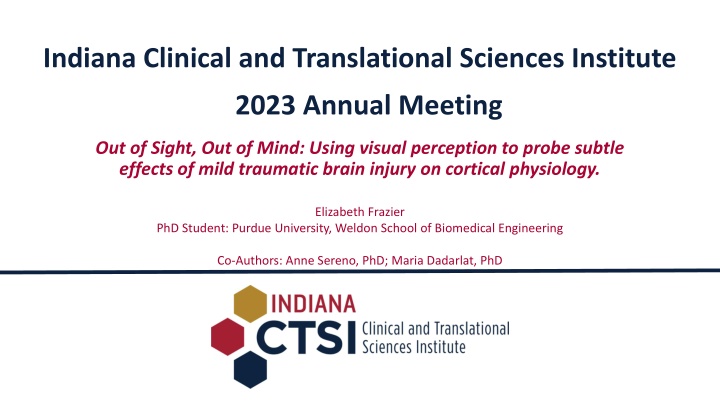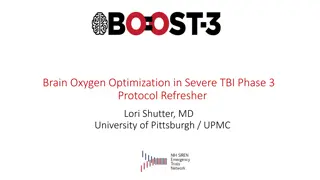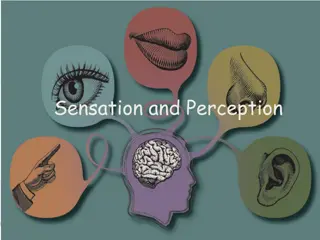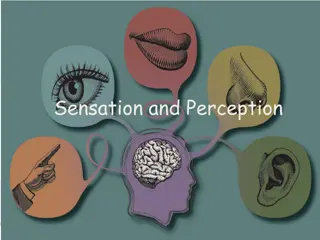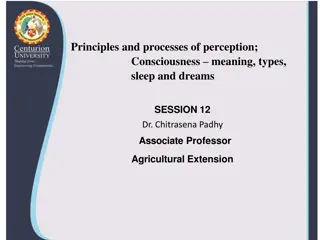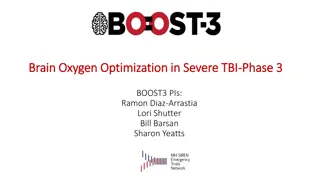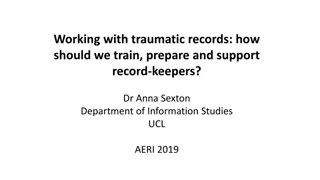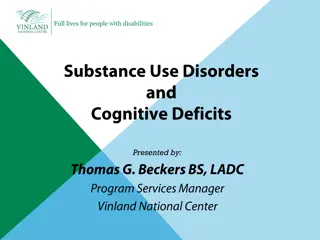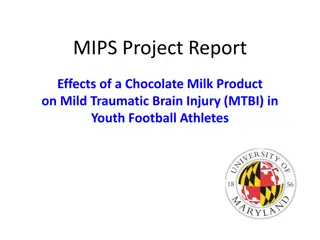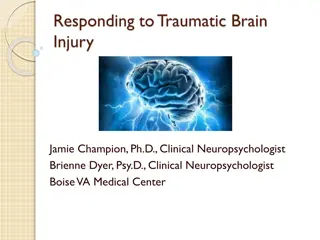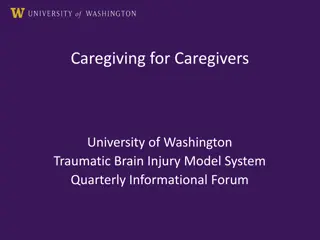Investigating Visual Perception Effects of Mild Traumatic Brain Injury
Elizabeth Frazier, a PhD student at Purdue University, explores the subtle effects of mild traumatic brain injury (mTBI) on cortical physiology using a novel two-alternative forced choice task in mice. The study aims to bridge visual deficits and cortical circuitry changes post-mTBI to improve diagnosis and monitoring, with potential implications for patient prognosis and rehabilitation.
Download Presentation

Please find below an Image/Link to download the presentation.
The content on the website is provided AS IS for your information and personal use only. It may not be sold, licensed, or shared on other websites without obtaining consent from the author.If you encounter any issues during the download, it is possible that the publisher has removed the file from their server.
You are allowed to download the files provided on this website for personal or commercial use, subject to the condition that they are used lawfully. All files are the property of their respective owners.
The content on the website is provided AS IS for your information and personal use only. It may not be sold, licensed, or shared on other websites without obtaining consent from the author.
E N D
Presentation Transcript
Indiana Clinical and Translational Sciences Institute 2023 Annual Meeting Out of Sight, Out of Mind: Using visual perception to probe subtle effects of mild traumatic brain injury on cortical physiology. Elizabeth Frazier PhD Student: Purdue University, Weldon School of Biomedical Engineering Co-Authors: Anne Sereno, PhD; Maria Dadarlat, PhD
Results | A behavioral task to probe post-mTBI visual deficits Traumatic brain injury (TBI) is a leading cause of death and disability. Mild TBI (mTBI) is particularly diverse in functional deficits and patient prognosis. Many mTBI patients suffer from visual dysfunctions and visual acuity loss. Neuropathology of mTBI disrupts cortical circuitry. Developed a novel two alternative forced choice (2AFC) task to probe perception of complex global motion stimuli in mice, compatible with head-fixation for in vivo electrophysiology Validated parameters to reliably generate mTBI in mice using a controlled cortical impact (CCI) Established framework to bridge visual deficits and cortical circuitry changes following mTBI. IMPROVING HEALTH THROUGH RESEARCH indianactsi.org
Methods | 2AFC task overview and mTBI validation mTBI: Mice receive a mild impact to skull over primary visual cortex 2AFC Task: Mice report global motion of a random dot kinematogram (RDK) with a wheel turn 2AFC Task Setup Sample Psychometric Data Controlled Cortical Impact Setup Impactor Parameters: 3 m/s tip velocity 0.8 mm depth 180 ms dwell time 3mm plastic tip RDK Coherence Created using Biorender. IMPROVING HEALTH THROUGH RESEARCH indianactsi.org
Future Work | Next steps and patient implications Overall Objective | Correlate physiological outcomes post-mTBI to simple, visual behavior outcomes. Acute, in vivo electrophysiology Immediate Next Steps | Bridge behavior with electrophysiology Acutely implant recording electrodes into the cortex of awake, behaving mice performing 2AFC task Assess changes in behavior (speed/accuracy) and physiology (RDK-evoked responses/functional connectivity) following mTBI Human Translation | Improve mTBI diagnosis and monitoring Facilitate estimation of latent physiological changes after mTBI using performance on simple behavioral tasks Improve prediction of mTBI prognosis Translate 2AFC task to an easily administered, cost-effective tool to improve diagnosis and rehabilitation of mTBI patients IMPROVING HEALTH THROUGH RESEARCH indianactsi.org
Grant Acknowledgement Thank you for your attention! This project was funded with support from the Indiana Clinical and Translational Sciences Institute which is funded in part by Award Number UL1TR002529 from the National Institutes of Health, National Center for Advancing Translational Sciences, Clinical and Translational Sciences Award. The content is solely the responsibility of the authors and does not necessarily represent the official views of the National Institutes of Health. IMPROVING HEALTH THROUGH RESEARCH indianactsi.org
